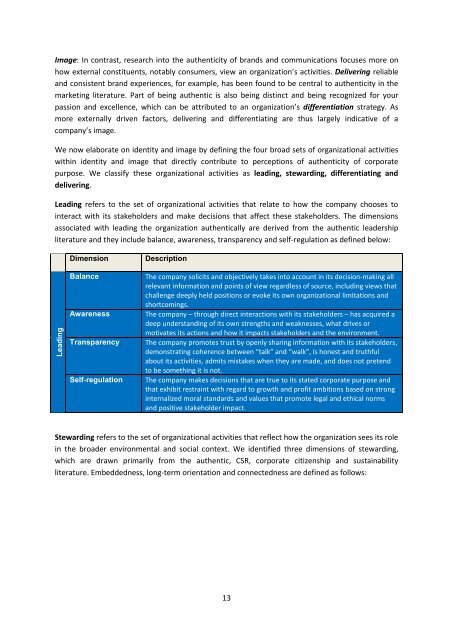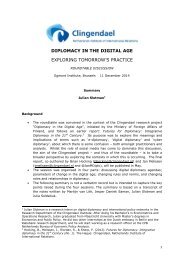BM_IMD_REPORT-How-Authentic-is-your-Corporate-Purpose
BM_IMD_REPORT-How-Authentic-is-your-Corporate-Purpose
BM_IMD_REPORT-How-Authentic-is-your-Corporate-Purpose
Create successful ePaper yourself
Turn your PDF publications into a flip-book with our unique Google optimized e-Paper software.
Leading<br />
Image: In contrast, research into the authenticity of brands and communications focuses more on<br />
how external constituents, notably consumers, view an organization’s activities. Delivering reliable<br />
and cons<strong>is</strong>tent brand experiences, for example, has been found to be central to authenticity in the<br />
marketing literature. Part of being authentic <strong>is</strong> also being d<strong>is</strong>tinct and being recognized for <strong>your</strong><br />
passion and excellence, which can be attributed to an organization’s differentiation strategy. As<br />
more externally driven factors, delivering and differentiating are thus largely indicative of a<br />
company’s image.<br />
We now elaborate on identity and image by defining the four broad sets of organizational activities<br />
within identity and image that directly contribute to perceptions of authenticity of corporate<br />
purpose. We classify these organizational activities as leading, stewarding, differentiating and<br />
delivering.<br />
Leading refers to the set of organizational activities that relate to how the company chooses to<br />
interact with its stakeholders and make dec<strong>is</strong>ions that affect these stakeholders. The dimensions<br />
associated with leading the organization authentically are derived from the authentic leadership<br />
literature and they include balance, awareness, transparency and self-regulation as defined below:<br />
Dimension<br />
Balance<br />
Awareness<br />
Transparency<br />
Self‐regulation<br />
Description<br />
The company solicits and objectively takes into account in its dec<strong>is</strong>ion‐making all<br />
relevant information and points of view regardless of source, including views that<br />
challenge deeply held positions or evoke its own organizational limitations and<br />
shortcomings.<br />
The company – through direct interactions with its stakeholders – has acquired a<br />
deep understanding of its own strengths and weaknesses, what drives or<br />
motivates its actions and how it impacts stakeholders and the environment.<br />
The company promotes trust by openly sharing information with its stakeholders,<br />
demonstrating coherence between “talk” and “walk”, <strong>is</strong> honest and truthful<br />
about its activities, admits m<strong>is</strong>takes when they are made, and does not pretend<br />
to be something it <strong>is</strong> not.<br />
The company makes dec<strong>is</strong>ions that are true to its stated corporate purpose and<br />
that exhibit restraint with regard to growth and profit ambitions based on strong<br />
internalized moral standards and values that promote legal and ethical norms<br />
and positive stakeholder impact.<br />
Stewarding refers to the set of organizational activities that reflect how the organization sees its role<br />
in the broader environmental and social context. We identified three dimensions of stewarding,<br />
which are drawn primarily from the authentic, CSR, corporate citizenship and sustainability<br />
literature. Embeddedness, long-term orientation and connectedness are defined as follows:<br />
13








